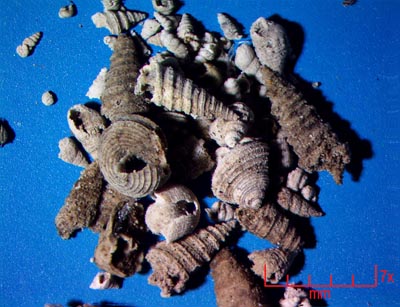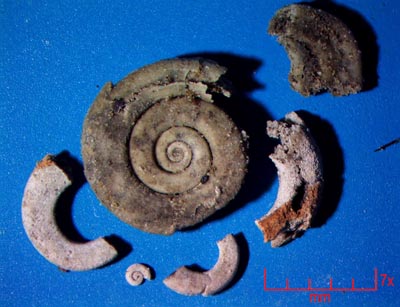|
Our survey
continues with what has been so far the least fossiliferous of
all the sites sampled so far. The fines from the acid bath were
dominated by ground up shell bits and very few fossils intact
were found. This is quite different from the first half of site
3. We also saw the return of dozens of stunning clear quartz
crystals, the first stromatoporoid ever found, several scaphopods
transitioning from teleoconch to adult. Plenty of terriginous
material (dirt) mixed in this batch, and the rocks appeared to
be more carbonate than previous batches and foamed violently
in the muriatic acid dillutions.
 |
Click
this thumbnail for the larger size. The parking area for the
trail is at bottom, and the sites are marked with pins. Site
3 is marked and is the start of this survey, and extends halfway
to site 4 marker. This write up is based on the collection of
one full ziploc bag of rocks from the area of site 3.5 - 4. Again,
this site is one of the best for micro fossils in Arizona, but
few if any larger fossils can be found here. |
What was found
As far as what
was found in a one gallon zip lock bag of rock, this list highlights
the best preserved specimens:
1. A very small amount of Urchin material that was very poorly preserved
2. Dozens of poorly persevered Branching / Encrusting Bryozoans
3. Half a dozen Serpulid Worm domiciles (Chonetes)
4. Dozens of nice Scaphopods, some approaching pencil sized.
5. One species of Ostracods
6. Several dozen of both superbly - and poorly preserved Gastropods
7. One sand grain covered with the metal coating
8. Two tiny Trilobite bits
9. Only four or five Bivalves - very generic
10. A few Straparollus gastropod parts with one complete pea sized specimen
11. And three partial Brachiopods (other than productids)
12. Two productid spines
13, Stromatoporoid pieces
And here is what was NOT found that had been at other sites along the trail:
1. No Sponges or sponge roots
2. No solitary rugose corals
3. Not a single crinoid ossicle
4. No Bellerophontid Gastropods
5. No Nautiloids
6. NO winged clams
For a site so poor
in fossils, there were a few surprises!
The
Fossil Photos.
A few words on
how these photos were taken. Using an Amscope stereo microscope,
one or two dozen shots of each subject were taken with the focus
shifted a bit between shots. The focus stacking software Picolay
was used to combine the images to obtain one frame of fully sharp
focus. Thousands of frames are treated in this manner and the
final images of the Fort Apache micro fossils you see here are
the results of a huge amount of work! Enjoy.
Trilobites:
 |
Phillipsia
sp. For this
gallon of rock sample, only two tiny fragments of the highly
sought after arthropod were found. A section of thoraxic ribs
on the left, a pices of cephalon, and on the right a doublure
(Rim). The color is diagnostic - ONLY trilobites and the ear
shaped ostracods (also arthropods) have the carmel colored silica. |
Brachipods:
 |
Pseudodielasma
sp. Three partial
brachs were found, which were the largest specimens in our sample
mix. |
Bryozoans:
 |
The
habit of these bryozoans is both encrusting and solitary small
branches. Most specimens the apertures were not clearly defined
due to poor preservation. They would often encrust urchin spines
to the point that the spine was unrecognisable. |
Chonetids
(Serpulid Worms):
 |
Loose
specimens are the remains of being attached to sea weed, and
thus are loose in the fines with one very flat side. Also shown
here, several chonetids are cemented to bryozoans which obviously
were dead at the time. At the top we have an urchin spine encrusted
by bryozans and then the serpulid attached on to the bryozoan. |
Bivalves:
 |
This is all we
found intact for bivalves! While the fines were mostly ground
up shell hash, none were recognisable.
Astartella subquandrata
(top), Palaeonucula levatiformis (upper right), Sanguinolites sp. (? Lower left)
|
Quartz
Crystals:
 |
Dozens
of very nicely formed quartz crystals made their appearance in
the mix. It seems the more we find these, the worse preservation
the fossils. |
 |
Close
ups of some of the better terminated specimens. Realize that
these are about the same size as a grain of sand. |
 |
40x
maximum magnification view of some of the fine crystal terminations. |
Gastropods:
 |
About
half a teaspoon of gastropods were found in the gallon of rock.
Half were so badly preserved, but still half were decent. A large
percentage were the spiral cones with the deep ribbing. |
 |
Cibecuia
cedarensis Two
of these new gastropod types were found, we had not found them
before at other sites. |
 |
Apachella
turbiniformis These
are pretty uncommon too. The preservation on these is excellent. |
 |
Knightites
modestus Some
of my favorites, these resemble Bellerophon, but are not related. |
 |
Palaeonucula
levatiformis Barrel
shaped with positive curvature. |
 |
Cibecuia
cedarensis This
was the largest specimen of this genus found. |
 |
Genus
and species indet. These
high spired turriculate cones are some of the most exciting finds
when preserved well like this. The smallest is less than the
size of a pin head. |
 |
Paleostylus
sp. Some of
these cones are superbly detailed. The transverse ribbing is
diagnostic. |
 |
Apachella
arizonensis Well
worn, but the shape is unmistakeable. |
 |
Apachella
arizonensis |
 |
Genus
and species indet. There
are hordes of these super tiny gastropods everywhere. They may
be juviniles of some of the larger finds. |
 |
Goniasma
terebra Stunning
shape with clear circular ribbing. |
Ostracods:
 |
Genus
and species indet. Only
one type of ostracod was found, the small clam shaped types. |
Scaphapods:
 |
Plagioglypta
canna Sizes
ranged from only a few mm to over an inch. Both smooth and ribbed
types found |
 |
Plagioglypta
canna The smaller
scaphopods showed once again the change from the circular ribbing
of the juvinile teleoconchs to the smooth surface of the adults.
The juvinile part easily breaks off in life and allows the water
to exit out the top when they are feeding in the mud. |
Productid
Spines:
 |
Bellaclathrus
spinosus Only
two spines from these productids were found. No larger brachs
were in the mix, we can only infer ther identity with thier spines. |
Stromatoporoid:
 |
Stroms
are a type of encrusting sponge with radial columns internal
to the outside to inside surfaces. This one is encrusting a spiny
urchin spine (Echinocrinus trudifer) |
 |
Close
up of the edge showing the radial tubes charecteristic of stromatoporoids. |
 |
Another
close up of edge. |
 |
Surface
close up. This is the first time ever we have found such an animal
in the Fort Apache. |
Straparollus
Gastropods:
 |
Straparollus
kaibabensis Same
species as in the overlying Permian Kaibab formation. Wide veiw
showing the complete specimen surrounded by sections of the whorl. |
 |
Straparollus
kaibabensis Juvinile.
One of the best specimens for showing the "Protoconch",
which is the tiny bud shaped part in the very center. This is
how the gastropod hatches from its egg, and then starts to spiral
shortly thereafter. |
Urchin:
 |
Echinocrinus
trudifer Very
few urchin parts survived the taphonomic filter at this site.
Seen here are some spines, tubercle plates and a few water vascular
system pores. |
 |
Echinocrinus
trudifer Close
up of plates found. |
|
